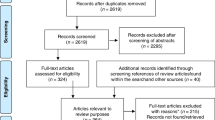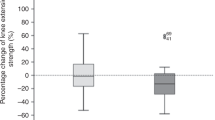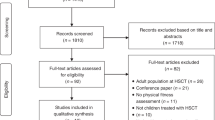Abstract
We present a set of tests for physical performance used for annual prospective follow-up after a pediatric transplant. Of the 103 eligible patients transplanted at a mean age of 8.8 years, 94 were included. The results were divided into early, performed 1 (n=46) or 2 (n=12) years post transplant, and late tests (n=66), performed 4–16 (mean 6) years post transplant. A total of 30 patients had tests both at early and late time points (paired tests). The control subjects included 522 healthy age- and gender-matched schoolchildren. Using their test results, the s.d. score (SDS) was calculated for each patient and for each test individually. Both in the early and late tests, patients had the mean SDS for each test significantly lower (P<0.001) than controls, varying from −0.6 to −2.0 SDS. Specifically, tests measuring trunk muscles gave impaired results. In the group with paired tests, the results improved in four of six tests. In late tests, age at SCT, extensive chronic GVHD and being a sports club member correlated with the results. The potential beneficial effect of an exercise intervention program on impaired physical performance after pediatric SCT merits prospective studies.
This is a preview of subscription content, access via your institution
Access options




Similar content being viewed by others
References
Socié G, Salooja N, Cohen A, Rovelli A, Late Effects Working Party of the European Study Group for Blood and Marrow Transplantation. Nonmalignant late effects after allogeneic stem cell transplantation. Blood 2003; 101: 3373–3385.
Syrjala K . Assessment of quality of life in hematopoietic cell transplantation recipients. In: Blume KG, Forman SJ, Appelbaum F (eds). Thomas’ Hematopoietic Cell Transplantation, 3rd edn, Blackwell Publishing Ltd: Oxford, 2004, pp 507–518.
Ness KK, Bhatia S, Baker KS, Francisco L, Carter A, Forman SJ, et al., The Bone Marrow Transplant Survivor Study. Performance limitations and participation restrictions among childhood cancer survivors treated with hematopoietic stem cell transplantation. Arch Pediatr Adolesc Med 2005; 159: 706–713.
Demark-Wahnefried W, Pinto BM, Gritz ER . Promoting health and physical function among cancer survivors: potential for prevention and questions that remain. J Clin Oncol 2006; 24: 5125–5131.
Dimeo F, Fetscher S, Lange W, Mertelsmann R, Keul J . Effects of aerobic exercise on the physical performance and incidence of treatment-related complications after high-dose chemotherapy. Blood 1997; 90: 3390–3394.
Dimeo FC, Tilmann MH, Bertz H, Kanz L, Mertelsmann R, Keul J . Aerobic exercise in the rehabilitation of cancer patients after high dose chemotherapy and autologous peripheral stem cell transplantation. Cancer 1997; 79: 1717–1722.
van Brussel M, Takken T, Lucia A, van der Net J, Helders PJ . Is physical fitness decreased in survivors of childhood leukemia? A systematic review. Leukemia 2005; 19: 13–17.
Hovi L, Era P, Rautonen J, Siimes MA . Impaired muscle strength in female adolescents and young adults surviving leukemia in childhood. Cancer 1993; 72: 276–281.
Mello M, Tanaka C, Dulley FL . Effects of an exercise program on muscle performance in patients undergoing allogeneic bone marrow transplantation. Bone Marrow Transplant 2003; 32: 723–728.
Marchese VG, Chiarello LA, Lange BJ . Effects of physical therapy intervention for children with acute lymphoblastic leukemia. Pediatr Blood Cancer 2004; 42: 127–133.
Ness KK, Baker KS, Dengel DR, Youngren N, Sibley S, Mertens AC et al. Body composition, muscle strength deficits and mobility limitations in adult survivors of childhood acute lymphoblastic leukemia. Pediatr Blood Cancer 2007; 49: 975–981.
Lucía A, Earnest C, Pérez M . Cancer-related fatigue: can exercise physiology assist oncologists? Lancet Oncol 2003; 4: 616–625.
Wiskemann J, Huber G . Physical exercise as adjuvant therapy for patients undergoing hematopoietic stem cell transplantation. Bone Marrow Transplant 2008; 41: 321–329.
Ness KK, Mertens AC, Hudson MM, Wall MM, Leisenring WM, Oeffinger KC et al. Limitations on physical performance and daily activities among long-term survivors of childhood cancer. Ann Intern Med 2005; 143: 639–647.
Sorva R, Perheentupa J, Tolppanen EM . A novel format for a growth chart. Acta Paediatr Scand 1984; 73: 527–529.
Committee of Experts on Sports Research (eds). Eurofit. European Test of Physical Ftness. Edigraf editoriale grafica: Rome, 1988, pp 72.
Viljanen T, Viitasalo JT, Kujala UM . Strength characteristics of a healthy urban adult population. Eur J Appl Physiol 1991; 63: 43–47.
Keskinen K, Häkkinen K, Kallinen M (eds). Kuntotestauksen käsikirja, 2nd edn, Liikuntatieteellisen seura (Finnish Society of Sport Sciences) publication no. 156 (in Finnish), Helsinki, 2004, pp 302.
Duell T, van Lint MT, Ljungman P, Tichelli A, Socié G, Apperley JF et al. Health and functional status of long-term survivors of bone marrow transplantation. EBMT Working Party on Late Effects and EULEP Study Group on Late Effects. European Group for Blood and Marrow Transplantation. Ann Intern Med 1997; 126: 184–192.
Hogarty AN, Leahey A, Zhao H, Hogarty MD, Bunin N, Cnaan A et al. Longitudinal evaluation of cardiopulmonary performance during exercise after bone marrow transplantation in children. J Pediatr 2000; 136: 311–317.
Hovi L, Rajantie J, Perkkiö M, Sainio K, Sipilä I, Siimes MA . Growth failure and growth hormone deficiency in children after bone marrow transplantation for leukemia. Bone Marrow Transplant 1990; 5: 183–186.
Sanders JE, Guthrie KA, Hoffmeister PA, Woolfrey AE, Carpenter PA, Appelbaum FR . Final adult height of patients who received hematopoietic cell transplantation in childhood. Blood 2005; 105: 1348–1354.
Phipps S, Dunavant M, Srivastava DK, Bowman L, Mulhern RK . Cognitive and academic functioning in survivors of pediatric bone marrow transplantation. J Clin Oncol 2000; 18: 1004–1011.
Gurney JG, Ness KK, Rosenthal J, Forman SJ, Bhatia S, Baker KS . Visual, auditory, sensory, and motor impairments in long-term survivors of hematopoietic stem cell transplantation performed in childhood: results from the Bone Marrow Transplant Survivor study. Cancer 2006; 106: 1402–1408.
White J, Flohr JA, Winter SS, Vener J, Feinauer LR, Ransdell LB . Potential benefits of physical activity for children with acute lymphoblastic leukaemia. Pediatr Rehabil 2005; 8: 53–58.
Florin TA, Fryer GE, Miyoshi T, Weitzman M, Mertens AC, Hudson MM et al. Physical inactivity in adult survivors of childhood acute lymphoblastic leukemia: a report from the childhood cancer survivor study. Cancer Epidemiol Biomarkers Prev 2007; 16: 1356–1363.
Dimeo F, Bertz H, Finke J, Fetscher S, Mertelsmann R, Keul J . An aerobic exercise program for patients with haematological malignancies after bone marrow transplantation. Bone Marrow Transplant 1996; 18: 1157–1160.
San Juan AF, Chamorro-Viña C, Moral S, Fernández Del Valle M, Madero L, Ramírez M et al. Benefits of intrahospital exercise training after pediatric bone marrow transplantation. Int J Sports Med 2008; 29: 439–446.
Acknowledgements
This study was supported by the Nona and Kullervo Väre Foundation.
Author information
Authors and Affiliations
Corresponding author
Rights and permissions
About this article
Cite this article
Hovi, L., Kurimo, M., Taskinen, M. et al. Suboptimal long-term physical performance in children and young adults after pediatric allo-SCT. Bone Marrow Transplant 45, 738–745 (2010). https://doi.org/10.1038/bmt.2009.221
Received:
Revised:
Accepted:
Published:
Issue Date:
DOI: https://doi.org/10.1038/bmt.2009.221
Keywords
This article is cited by
-
Physical performance capacity after pediatric kidney transplant and clinical parameters associated with physical performance capacity
Pediatric Nephrology (2023)
-
Physical and functional performance assessment in pediatric oncology: a systematic review
Pediatric Research (2022)
-
Cardiorespiratory fitness and physical performance after childhood hematopoietic stem cell transplantation: a systematic review and meta-analysis
Bone Marrow Transplantation (2021)
-
Long-term health outcomes in survivors of childhood AML treated with allogeneic HSCT: a NOPHO–AML Study
Bone Marrow Transplantation (2019)
-
Short and long-term impairments of cardiopulmonary fitness level in previous childhood cancer cases: a systematic review
Supportive Care in Cancer (2019)



